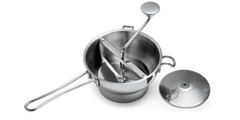I made leek & potato soup today, following a recipe from Anne Sheasby’s “The New Book of Soups”, and it was very good. This book is becoming a favourite!
Afterwards, I went to look for other recipes to see how they compared. I was surprised to see a number of recipes telling you to use a blender or food processor to puree the soup once the ingredients have been sweated and softened. Sheasby’s book explicitly says that, if you do use a blender or food processor in this manner, the soup will take on a gluey texture.
It’s no surprise, then, that I also found discussion threads online where people were asking why their leek and potato soup had gone gluey. The answer, apparently, is to do with the starch molecules in the potatoes being liquified and possibly overworked.
So, what does Sheasby’s book suggest for pureeing the soup? It suggests pushing it through a sieve or using a food mill. I started with a sieve and ended up getting the food mill out, with the most coarse cutting disc – I could quickly tell it was going to be too much of an ordeal to push so much flesh through a sieve. I’m surprised it even suggested the sieve at all and wonder if it was a matter of “well, a food mill is required but if what if you haven’t got one?”.
The food mill was a lot of work, though, so I can see why the blender is tempting. Still, the result was good so it was worth it in the end.
This is what food mills look like. You can use them for quite a few things. I’ve used it for apple sauce, and you can also use it for things like very creamy mashed potatoes:
